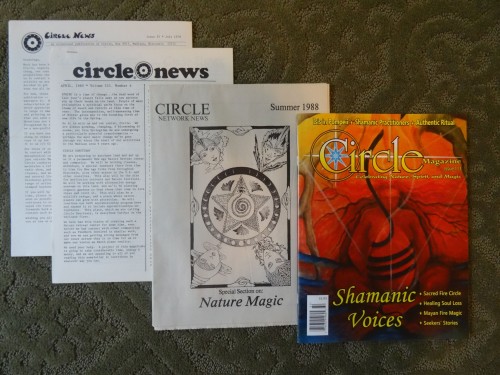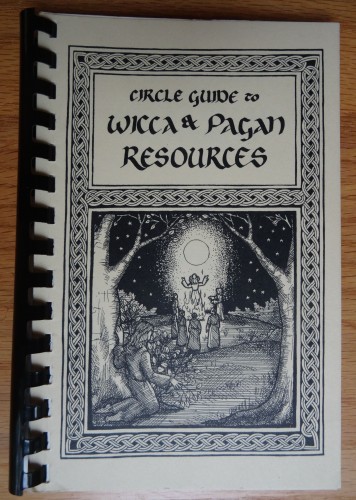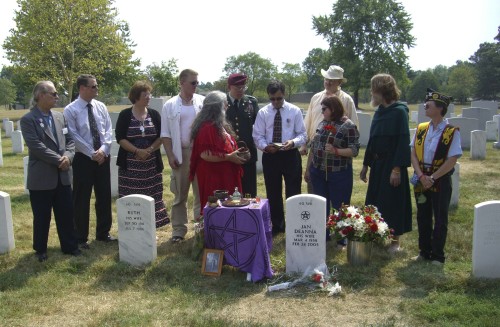[Our Fall Funding Drive is still going on. Your support and your donations are what make our work possible. If you like reading our articles, like the one below, and commentary on a daily basis, please consider donating today to help keep The Wild Hunt going for another year. We are now very close to our goal. Will you help us reach it? Donate here. Thank You.]
“I didn’t really set out to be a priestess for a living . . . that’s what happened.” — Selena Fox
Indeed, that’s what happened. Selena Fox is the High Priestess for Life at Circle Sanctuary, a legally recognized Shamanic Wiccan church that will be marking its 40th year this Samhain, October 31 and is celebrating with events and online reflections all month. The Wild Hunt spoke with Reverend Fox and several longtime members of Circle, as it is alternatively known, to get a sense of what Paganism looked like in 1974, and how Circle Sanctuary has participated in its evolution.

Circle Sanctuary logo
Circle is aptly named, as circles are particularly significant in Wiccan theology, serving as both the border of sacred space and a metaphor for the repeating cycles of life. Over the past four decades, the group has focused a lot of its energy on the beginnings and endings of life. Its Lady Liberty League was instrumental in efforts to get the pentacle approved as a religious symbol on military headstones; the group’s retreat center now includes a Pagan cemetery; and Reverend Fox has performed dozens of baby blessings, including one for this reporter’s long-since-grown stepson. The church’s calendar begins each year at Samhain, around which time some of the most significant milestones in its history tend to congregate.
In late October 1974, Fox “had a vision of starting Circle Sanctuary, the name and logo came to me, as well as the concept of having a rurally-based center that would help humans of different nature religion paths connect with each other, as well as the circle of nature of which we are all a part.”
Before the explosion of online social media, Paganism was a very different group of religions. How diverse the religions were under the Pagan umbrella is difficult to say. Solitary practitioners were very isolated, while some people practiced together in circles, covens, and groves. In the days before Drawing Down the Moon and The Spiral Dance, books were rare and publications, such as Green Egg, were the best source of knowledge. Fox had been traveling and working with Pagans around the country, “but it was not very public,” she recalled.

CIRCLE Magazine’s incarnations over time
With a vision clear in her mind, Fox put an ad in the Witches’ Almanac, inviting like-minded individuals to write to her at a Madison, Wisconsin post office box. From those early responses she formed a core group that rented some land and lived together. Networking locally wasn’t quite enough to satisfy her desire to connect across traditions.
So Circle began publishing a two-sided, typewritten newsletter and, together with her partner at the time Jim Alan, Fox became one of the earliest traveling Pagan musicians in the United States. She said:
Now it’s common for Pagan musicians to travel, and for there to be festivals, but in the 70s there was not much in the way of face-to-face communication across traditions. We felt called to do that.
There were other calls, as well, and other things for which Circle found itself at the forefront. Fox’s chants became a songbook, for which there was an incredible demand. They experimented with radio and television before most other Pagan groups, and still produce podcasts today.

First edition of Circle Guide
But 1979 was the year that Paganism in general — and Fox in particular — got pulled into the public spotlight. It was the year that Margot Adler’s Drawing Down the Moon was published on the east coast, and Starhawk’s The Spiral Dance was released in the west. Circle began putting out the Circle Guide to Wicca & Pagan Resources to help Pagans find each other. It was also the year that Time magazine set out to write about Paganism for its religion page, which was a significant departure for the staid publication. To that end, Time staffers went to the Pan Pagan Festival in Indiana to learn more.
“I happened to be doing a handfasting, and that got their attention,” Fox said. “Maybe it was the broom.” A picture of Fox, holding the broom aloft, accompanied the Time piece on Paganism, and led to her being “bombarded with media requests,” including an interview in People magazine. The coverage was largely positive, and “really positive things came out of it.”
While the seventies were a time of change, no change comes easy. After four years in the same place “with no problems,” Circle’s landlord decided to evict the group due to the media interest. The eviction came from the sheriff right after Samhain, and they were faced with finding a new place with the Wisconsin winter looming before them.
With her typical optimism, Fox explained what went through their minds when dealing with the big pile of lemons that life had dealt them. She said, “Sometimes, you really just have to make lemonade. We found an opportunity to rent month-to-month, and we moved up the timetable to buy our own land.”
 Acquiring land for Pagan use was also a new idea. But in 1980 Circle Network News evolved from a two-page newsletter to a newspaper, and carried in it the announcement of the ambitious project. The network of Pagans, who had been corresponding through Circle’s network and meeting at the occasional festival, responded with half-throated support. “There were a lot of different opinions about that,” Fox said. A vocal portion of the Pagan community raised concerns about adopting an institutional model. Circle had incorporated as a church just two years earlier, and acquiring land raised a red flag for some. But several years later, in time for Samhain 1983, those who supported the idea had their way, and the land, destined to be the Circle Sanctuary Nature Preserve, was bought by the organization.
Acquiring land for Pagan use was also a new idea. But in 1980 Circle Network News evolved from a two-page newsletter to a newspaper, and carried in it the announcement of the ambitious project. The network of Pagans, who had been corresponding through Circle’s network and meeting at the occasional festival, responded with half-throated support. “There were a lot of different opinions about that,” Fox said. A vocal portion of the Pagan community raised concerns about adopting an institutional model. Circle had incorporated as a church just two years earlier, and acquiring land raised a red flag for some. But several years later, in time for Samhain 1983, those who supported the idea had their way, and the land, destined to be the Circle Sanctuary Nature Preserve, was bought by the organization.
Circle Sanctuary bought their land in 1983, and by doing that Circle transformed the community and their organization: people put down roots here, and some portion of the organizational energy flow shifted toward maintenance and stewardship of the land. That exerted a powerful stabilizing influence.– Bob Paxton, a 20+ year Circle member
That stabilizing influence allowed the organization to start focusing on helping people whose problems stemmed from being Pagan. “It does help to have some kind of institution when you’re fighting for Pagan rights,” Fox explained. The land allowed Circle to ramp up holding festivals of its own, such as Pagan Spirit Gathering, and use those events to fund other activities, which included public education and assistance for those being discriminated against.
That work was increasingly needed as this was the time when the United States was gripped by a “Satanic panic.” In Fox’s mind, it also led to what happened next. But the events she described are complex, so it’s not easy to draw clear lines of cause and effect.
- 1983: Circle members began remodeling buildings on their new property, including the conversion of a barn into the church’s headquarters. “In the 1980s, people were running businesses and non-profits out of barns . . . it seemed to be common practice,” Fox said.
- 1984: A zoning administrator from the county came by to inquire into the work being done. “He starts asking questions, So I ask him some back,” Fox recalled, such as, “Are you asking people having boy scout meetings in their homes?” She adds, “I was polite, but it was really clear somebody was opposed to us having a Pagan center on that land. The administator couldn’t find anything to charge us with, so we did not hear for awhile.”
- 1985: Circle applied for — and received — the necessary permits to do additional work, to remodel part of an old, historic barn into offices. “We had no building inspectors in that rural area back then, and started remodeling,” Fox said.
- 1985: In September, three amendments were circulating through Congress with the aim of stripping tax-exempt status from organizations that “promote witchcraft.” One of these was attached to a tax-reform bill by unanimous voice vote of the Senate. Originally introduced by North Carolina Senator Jesse Helms to an appropriations bill for the postal service, the bill got the attention of many Pagans including those in Circle. “We got very involved in battling that,” Fox said. “We sent out thousands of fliers, urging people to contact their congress people about this.”
- 1985: Just in time for Samhain, the amendment was laid aside in joint conference, having been deemed “not germane” to the bill.
- 1986: Local zoning officials sent Circle a notice of violations that could result in fines of a hundred dollars a day. In Fox’s words, “The zoning wars began. We got an attorney, went to the first meeting, which should have been a discussion of traffic patterns and sound, but it wasn’t — it was about religion. Government officials were attacking our religion in a government meeting. The room was packed with people riled up and concerned.” She later learned that much of that concern came from an earlier meeting, held without notice in violation of open meeting laws. In that meeting, attendees were shown a Geraldo Rivera special about Satanic crime in America, spliced in with some footage of Fox on the Phil Donahue and Today shows.
- 1987: An “intense religious battle” continued to be waged with the press reporting on discrimination, while Circle Sanctuary was subjected to trespassing and threats of violence and death. Reverend Fox called this: “close encounters of a problematic kind.”
- 1988: The “zoning wars” ended when Circle Sanctuary received the church zoning designation that local officials had said it needed. Fox attributes the success in large part to the network of Pagans and others who rallied to support the church. But, in the end, the ACLU attorney working on the church’s behalf was able to secure a settlement without going to court, “when [local officials] realized we knew they were doing illegal things.”
Whether the “zoning wars” were directly connected to the fight against the Helms amendment can’t be corroborated either way, but it felt that way to Fox. That time was also a test for the nascent Lady Liberty League, which Circle had formed in the wake of that federal fight to defend Pagan rights. “In its earliest days, it was involved in our own Pagan rights cause,” Fox said.
The reason the land purchase was, and still is, so important to Circle’s success, is because it established a place where shared activities could occur and collaborative activities could occur. Over the many years I have been involved with Circle, it has become plain to me that people working together on projects, helps people form bonds. The more passionate people are about the work and the results of the work, the stronger the bonds. Wherever I go now, that is one of my primary mantras; collaborate together on projects that deliver real consequences in our own lives and to the benefit of the many outside of our own selves. — Nicholas Sea, Circle member since the 1970s

The first Pagan-Christian VA marker was placed in 2007.
The years since have been perhaps less turbulent, but no less active for Circle Sanctuary. Its cemetery project began in 1995, after the land was paid off, and now has about 25 people interred on the grounds. Lady Liberty League led the charge to get pentacles onto military headstones to honor the Wiccan fallen. Although Fox’s role is enshrined in the by-laws, the organization includes its members in decision making. It recently completed developing a strategic plan that sought input from all community members, and is now surveying users of its lands for their input into the nature preserve’s future.
And Circle is active in interfaith dialogue, including that which takes place within Paganism. “Our world is not a monoculture,” Fox said, “and neither is Paganism. It’s a beautiful diversity. Everyone can be enriched by being part of a larger community. We do have to problem solve around issues having to do with language in different traditions, there are some challenges but it’s still a really exciting thing.”
Rev. Selena Fox may not have set out to be a full-time priestess, but as High Priestess for Life at Circle Sanctuary, Selena Fox has had close encounters of the historic kind. For four decades, Paganism has unfolded around this organization, much of which is not included in this remembrance. On Oct 22, Circle Sanctuary will have a call-in radio show celebrating its anniversary, providing another opportunity for interested readers to hear more of Circle’s story.
The Wild Hunt is not responsible for links to external content.
To join a conversation on this post:
Visit our The Wild Hunt subreddit! Point your favorite browser to https://www.reddit.com/r/The_Wild_Hunt_News/, then click “JOIN”. Make sure to click the bell, too, to be notified of new articles posted to our subreddit.

Congrats to Circle Sanctuary for 40 years! That’s definitely a milestone. It must have been very difficult during the Satanic panic years to keep going, and Circle’s determination and dedication shines bright. Thank you, Circle, for your many years of service to the community.
Warm thoughts and Congratulations to Circle Sanctuary and its members on this anniversary. Thank you for the pioneering work in so many areas that benefit us all.
Congratulations to Circle on 40th anniversary!
When we are able to look back on our lives and know we have played a part in weaving a tapestry larger than ourselves, and realize there are many such tapestries out there, a quiet comes. It is in that quiet where new voices can be heard, illuminating the way. What a delight it is to celebrate these many anniversaries.
Many, many, many congratulations to Selena and Circle. I’d love to see a follow up article that explains what Selena and Circle have done that has allowed them to survive and grow while so many Pagan community centers, communes, farms, etc. have fallen apart. As Pagans struggle to grow infrastructure, we need to look at those who have done and see what they’ve done and what they’ve avoided. Selena, you need to write this book,
I think it’s probably impossible for Pagans who are used to finding all the resources they could imagine online to understand just what those copies of Circle Network News meant to us back in the 1980s. Though it was still theoretically possible to find some solid Pagan books, you generally had to find a sympathetic bookstore owner first, and get them by special order. And a book is not a community: finding others who also celebrated any form of Pagan religion was mostly a matter of happenstance. (The reason I became Wiccan rather than a Druid was simply that I was lucky enough to discover Wiccans near me; it was years before I met my first Druid.)
For a Pagan in the country, finding other Pagans involved a lot of effort, and often required outing ourselves in the process.
In the middle of all that, Circle Network News was unique, with stories from many perspectives, in many voices on magickal techniques, divination, deities, and ideas for deepening our practice. It was the link to the wider Pagan world, the first step toward discovering the range of Pagan practices out there, and the gatherings where we would cross-pollinate our ideas.
Indeed, the very first Pagan I ever met, Kirk White, made me friend for life when he hauled out from under his bed his precious shoeboxes stuffed with tattered copies of Circle Network News, and then let me borrow them.
Cat, thank you for this perspective. It helps illuminate how precious the history in our heads and shoeboxes(!) are. Also it illustrates the importance of supporting the various Pagan History and Library projects – each building the infrastructure to preserve exactly the insights you just shared.